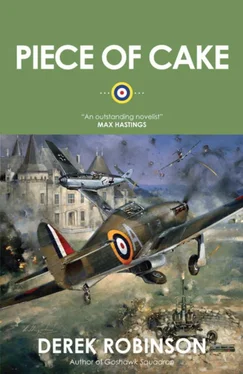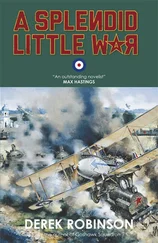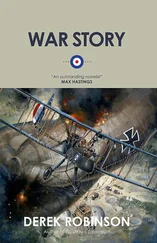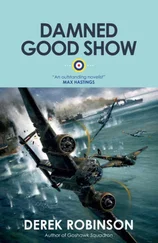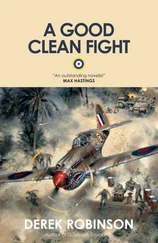“Wrong, old boy. The controller says we’re released to forty-minute availability until twelve-noon. And there’s something else, too. The Ram wants slit-trenches dug. Somewhere near dispersal, he says, so you can all dive into them if Jerry suddenly pays a visit. Right here would do, I suppose.”
Starr whacked his heel against the turf and failed to make a dent. “Pure concrete,” he said. “We’ll break our necks.”
“I’d better get the digging started.” Kellaway went in search of the NCO’s.
The purpose of a battle climb was to lift the squadron to combat height in the minimum time. It was hard work for men and machines, the engines slogging away to win a couple of thousand feet every minute, the pilots having to hold tight formation through cloud and air pockets and a change of atmosphere equivalent to climbing the Alps in a quarter of an hour. There was no chance to relax: everything and everyone toiled flat-out. It was the Ram’s favorite maneuver.
“Jester Leader to Red Three: close up, damn you,” he ordered for the third time.
Stickwell was Red Three. His wingtip was ten feet from the Ram’s wingtip. He cut the gap to five feet and concentrated grimly on holding position. His stomach kept jumping as if someone were poking it with a pencil, and his mouth tasted stiff and sour; also his skull seemed to be pressing down on his eyeballs. He knew it was only a matter of time before he was sick.
At last the Ram looked away from him. Just you wait, Flying Officer Stickwell, the Ram said to himself. I’ll teach you to get blotto. I’ll spread your guts all over this sky before I’m through. He opened his transmission switch. “Jester Leader to Red Two: where the hell d’you think you’re going?” he said.
Cattermole was Red Two. He had already been sick: the effect of too much pure oxygen on a system thoroughly abused by alcohol and horse-riding. Oxygen was a well-known hangover cure for fighter pilots but on this occasion, although it had cleared his head, it had also emptied his stomach. He didn’t mind being sick but the vomit had splashed onto his gloves and made them slippery. Whenever he tried to wipe them clean, he wandered out of formation. “Sorry, Leader,” he said, and drifted back.
You’ll be sorry when we get back, all right, the Ram thought. You won’t even stay for lunch, my lad. He checked on Blue Section. “Tighten up, Blue Leader,” he said. “Stop dawdling.” Flip Moran brought his section forward by half a length, and the Ram put a mental question mark beside Blue Two. Miller. Moke Miller. Always larking about. Not a bad pilot but harebrained, no strength of character. It took more than flying ability to be a fighter pilot. In this squadron, anyway…
At seventeen thousand feet they leveled out and gained speed until they were cruising at about two hundred miles an hour. The last layer of cloud was a mile below them. They seemed to be hanging in a vast blue dome.
“Tighten up, everyone,” the Ram said. “Stop wasting space.”
The squadron inched together. Pip Patterson, flying as Yellow Three, had to watch his section leader on his right and also keep an eye on Red Two, ahead to his left. Both planes were so close he could count the rivets in the cockpit panels. Fanny Barton was Yellow Leader and he kept a straight enough course, but Moggy Cattermole was forever straying sideways. Patterson’s hands were sweating. His ears buzzed and popped; they didn’t like battle climbs, and every time they popped, a shower of tiny specks flickered across his eyes. He hated Moggy Cattermole’s bad flying. If Moggy drifted out any further, Pip would have to fall back to miss him. Green Section was just behind. Pip had once seen the tailplane of a Hurricane after it had been chewed up by a propeller. It was a mess. The propeller hadn’t been much good for anything, either. How the hell did you get down—three miles down—with a smashed rudder? Or a bust prop? Or—if bloody Moggy hit you and knocked you back into Blue Two—with both?
“Sections line astern,” the Ram announced. “Flights echelon port. Go!”
He held his position and watched closely for blunders. Green Section swung away to its left, clearing the air behind him. Red Two dropped into the space behind his tail, Red Three fell in behind Red Two. Yellow Section followed, each aircraft keeping slightly below the one in front in order to miss its wash. Now “A” flight was in line astern and completely invisible to the Ram. He studied “B” flight. They were almost in formation, weaving snake like as an adjustment worked its way through, then settling into a straight line. Not bad, not bad at all. “Shambles,” he told them. “Sloppy, scruffy, slow. Wake up! Squadron in vic. Sections astern. Go!” The section wingmen swung out, reformed vics, closed up. He looked across at the twin arrowheads of “B” flight. “Wake me when you’ve finished,” he said. “And remind me to give you something for your arthritis. Squadron in vic, sections echelon starboard. Go!”
The Ram drilled his squadron intensively for the next half-hour, often changing course as he changed formation, sometimes changing altitude too, and always nagging at them to tighten up, sharpen up, get a move on. It was relentlessly demanding work, but the knowledge that a single misunderstanding could mean a collision completely overcame fatigue; at the end even Cattermole felt clearheaded.
“We can’t have a battle climb without a battle,” the Ram announced. “Lacking enemy aircraft, we shall make do with cloud formations, which even you should be able to hit.” He led the squadron down in a series of plunging power-dives, each culminating in a mock-attack that led to a steep, turning climb and a rapid change of formation to set up the next power-dive. They finished within sight of the airfield. The Ram put them into sections line astern and took them into the circuit.
All the way down he had been thinking about whom to chop. Cattermole, obviously. And Stickwell, of course. Cox? Yes, Cox had asked for it. Miller, too. That made four. Chopping four ought to shake up the rest more than somewhat, he thought.
Halfway around the circuit. Speed: 160 and falling. Undercarriage selector lever to “down.” Usual hydraulic whining. Double clunk as the wheels lock. Green light on. All correct.
The big question was: when to chop? Sooner the better, obviously. But with the international situation so tricky the squadron couldn’t be left below strength. Not even for a day.
Speed: 135 and falling. Height: seven hundred feet. Slide the hood open and lock it. Nice bit of breeze. Downwind leg. Turn to port. Nice view of the rest of the squadron all strung out, descending. Good plane, the Hurricane. Tough, fast, chunky. And lethal. Blast any bloody Heinkel or Junkers to hell and gone in ten seconds. Five, even. Flaps down. Final approach.
Well, they would all play in this game of rugger, anyway, chopped or not. Do them good. Got to be fit to fight.
Over the barbed wire. Usual crowd waiting to watch the squadron land: groundcrew, fire tender, bloodwagon. And the adjutant, standing over there at the side all on his own. Funny how you could recognize people by the way they stood…
Maybe four was too many. Three might do. Give Cox another chance. Yes.
Down. Down. Gently down. All power off… now! Up comes the nose and onward she floats, sinking, sinking, until bump, rumble and squeak, she touches the ground and runs.
Yes, chop three. If not today at least tomorrow. But why not send for replacements now, immediately? Of course, good idea! They might even arrive tonight, with luck. Why not indeed? Yes, definitely. Got to get the old adj cracking on that straight away. Where was the old adj?
Читать дальше
